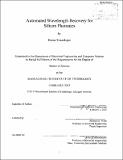Automated wavelength recovery for silicon photonics
Author(s)
Timurdogan, Erman
DownloadFull printable version (17.60Mb)
Other Contributors
Massachusetts Institute of Technology. Department of Electrical Engineering and Computer Science.
Advisor
Michael R. Watts.
Terms of use
Metadata
Show full item recordAbstract
In 2020, 1Tb/s on-/off-chip communication bandwidth and ~100fJ/bit total energy in a point to point link is predicted by Moore's law for high performance computing applications. These requirements are pushing the limits of on-chip silicon CMOS transistors and off-chip VCSELs technology. The major limitation of the current systems is the lack of ability to enable more than a single channel on a single wire/fiber. Silicon photonics, offering a solution on the same platform with CMOS technology, can enable Wavelength Division Multiplexed (WDM) systems. However, Silicon photonics has to overcome the wafer level, fabrication variations and dynamic temperature fluctuations, induced by processor cores with low-energy high-speed resonators. In this work, we offer a solution, called as Automated Wavelength Recovery (AWR), to these limitations. In order to demonstrate AWR, we design and demonstrate high performance active silicon resonators. A microdisk modulator achieved open eye-diagrams at a data rate of 25Gb/s and error-free operation up to 20Gb/s. A thermo-optically tunable microdisk modulator with Low power modulation (1 If/bit) at a data rate of 13-Gb/s, a 5.8-dB extinction ratio, a 1.22-dB insertion loss and a record-low thermal tuning (4.9-[mu].W/GHz) of a high-speed modulator is achieved. We demonstrated a new L-shaped resonant microring (LRM) modulator that achieves 30 Gb/s error-free operation in a compact (< 20 [mu]m²) structure while maintaining single-mode operation, enabling direct WDM across an uncorrupted 5.3 THz FSR. We have introduced heater elements inside a new single mode filter, a LRM filter, successfully. The LRM filter achieved high-efficiency (3.3[mu]W/GHz) and high-speed ([tau]f ~1.6 [mu]s) thermal tuning and maintained signal integrity with record low thru to drop power penalty (<1.1 dB) over the 4 THz FSR and <0.5dB insertion loss. We have integrated a heater driver and adiabatic resonant microring (ARM) filter in a commercial bulk CMOS deep-trench process for the first time. The proposed AWR algorithm is implemented with an ARM multiplexer. An advanced method for AWR is also introduced and demonstrated with passive resonators.
Description
Thesis (S.M.)--Massachusetts Institute of Technology, Dept. of Electrical Engineering and Computer Science, 2013. Cataloged from PDF version of thesis. Includes bibliographical references.
Date issued
2013Department
Massachusetts Institute of Technology. Department of Electrical Engineering and Computer SciencePublisher
Massachusetts Institute of Technology
Keywords
Electrical Engineering and Computer Science.